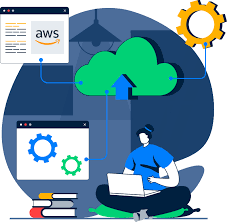
Introduction
Amazon Web Services (AWS) is one of the most widely adopted cloud platforms, providing a vast array of services to help businesses scale and innovate faster. AWS offers more than 200 services, but not all are needed for every application. In this blog post, I’ll share the main AWS services I have used in my experience, explaining how they can add value to any project.
1. Amazon EC2 (Elastic Compute Cloud)
One of the core services that AWS offers is Amazon EC2, which provides scalable virtual servers for your computing needs. I have used EC2 extensively for running various applications, especially when I needed to control the server configuration and scale the computing power based on the demand. EC2 gives flexibility in choosing the instance types, operating systems, and configurations, making it perfect for hosting websites, managing backend processes, or handling high-traffic applications. Enroll for AWS Training in Hyderabad at one of the best training institute. Kelly Technologies provide real-time faculty, course material and 100% Job placement.
With EC2, I could easily adjust the computing capacity using Auto Scaling, ensuring that resources are used efficiently, whether demand is increasing or decreasing. Its integration with other AWS services, like Elastic Load Balancing and Amazon CloudWatch, ensures seamless operation, improving application performance.
2. Amazon S3 (Simple Storage Service)
Another essential AWS service I frequently use is Amazon S3, a highly scalable and durable object storage service. Whether you need a place to store data backups, media files, or any other type of data, S3 is the perfect solution. I’ve used S3 for storing large datasets and static website content because of its flexibility, durability, and ease of access.
One of the standout features of S3 is its integration with other AWS services, such as AWS Lambda and Amazon CloudFront, making it ideal for building serverless applications or distributing content globally. Additionally, with S3 Versioning, I could easily manage data versions and maintain data integrity.
3. Amazon RDS (Relational Database Service)
Database management is crucial for any application, and Amazon RDS simplifies the process of setting up, operating, and scaling a relational database in the cloud. I have used RDS for hosting databases like MySQL and PostgreSQL in various projects. It’s an excellent choice for automating tasks like backups, patching, and scaling, which significantly reduces the time spent on manual database management.
RDS also supports Multi-AZ deployments for high availability, meaning it creates replicas of the database in different zones, ensuring that applications can run seamlessly even in the event of failure. This feature has been critical in building fault-tolerant and highly available applications.
4. AWS Lambda
AWS Lambda is another service I’ve extensively worked with, particularly for serverless computing. Lambda allows you to run code without provisioning or managing servers, which is perfect for building microservices or automating tasks. I have used Lambda to process data, manage back-end processes, and trigger events in response to changes in my environment.
Lambda integrates well with services like Amazon S3, DynamoDB, and API Gateway, making it possible to build highly scalable and cost-efficient applications. One of its key advantages is that you only pay for the compute time you consume, which has been cost-effective for many of my projects.
5. Amazon CloudFront
For projects that required fast content delivery to users across the globe, I used Amazon CloudFront, a content delivery network (CDN). CloudFront accelerates the distribution of static and dynamic content by caching it at edge locations worldwide. I found it particularly useful when delivering websites, videos, and APIs to a global audience with minimal latency.
CloudFront integrates with other AWS services, such as S3 and EC2, making it a powerful tool for improving website performance and user experience. Its security features, including AWS Shield and AWS Web Application Firewall (WAF), offer enhanced protection against common web threats, further safeguarding my applications.
6. Amazon VPC (Virtual Private Cloud)
When working on projects that required secure networking, I often relied on Amazon VPC to isolate and control network environments. VPC allows users to create private networks within the AWS cloud, where they can launch AWS resources in a virtual network that they define.
By using VPC, I was able to control inbound and outbound traffic for my applications with security groups and network ACLs (Access Control Lists). This level of control over network traffic improved the security posture of my applications, making them more resilient to external threats. Enroll for AWS Course in Hyderabad at one of the best training institute. Kelly Technologies provide real-time faculty, course material and 100% Job placement.
7. AWS IAM (Identity and Access Management)
Security is a top priority when working with cloud services, and AWS IAM plays a critical role in managing permissions and access control. I used IAM to create and manage AWS users and groups and to grant them permissions based on specific roles.
IAM’s fine-grained control over permissions ensures that users only have access to the services and resources they need. For example, in some projects, I assigned limited roles to team members, such as allowing access to S3 buckets or Lambda functions, but restricting access to sensitive services like EC2 or RDS. This practice enhances security and prevents unauthorized actions.
Conclusion
This article in the pencraftednews must have given you clear idea about AWS offers a comprehensive suite of cloud services, and those listed above are some of the most essential I’ve used. Whether it’s computing with EC2, storage with S3, database management with RDS, or serverless computing with Lambda, AWS provides the tools necessary for building scalable, secure, and efficient applications. By leveraging these services, businesses can innovate faster, reduce operational overhead, and provide better experiences to their customers. If you are new to AWS or looking to expand your knowledge, I highly recommend exploring these core services to enhance your cloud-based projects.







